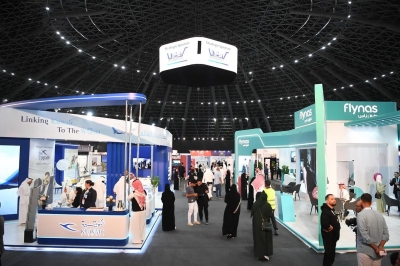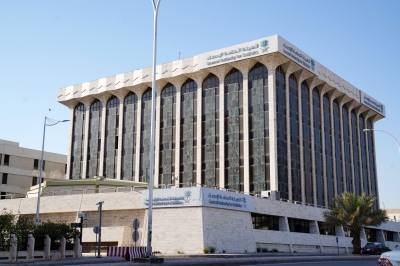
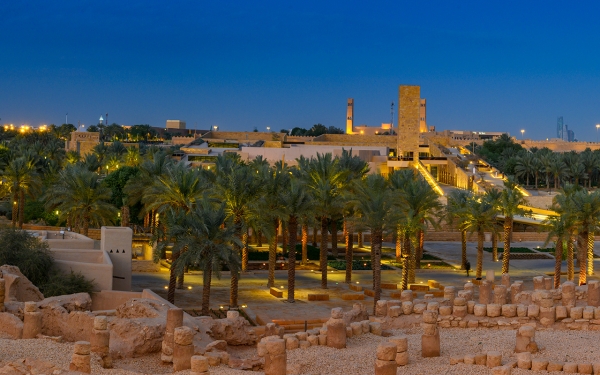
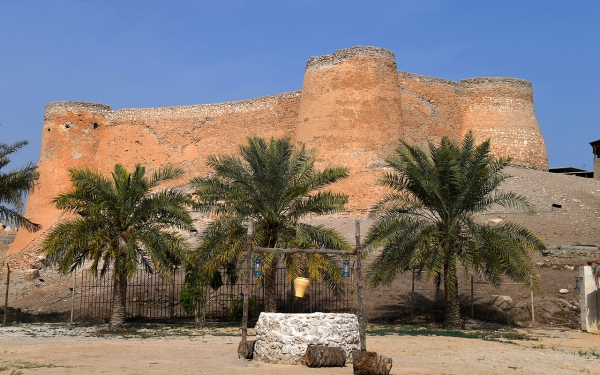
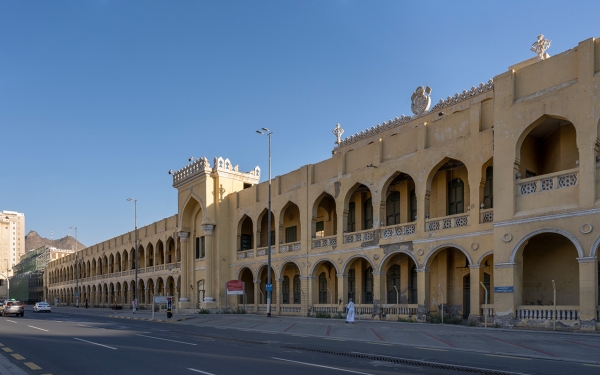
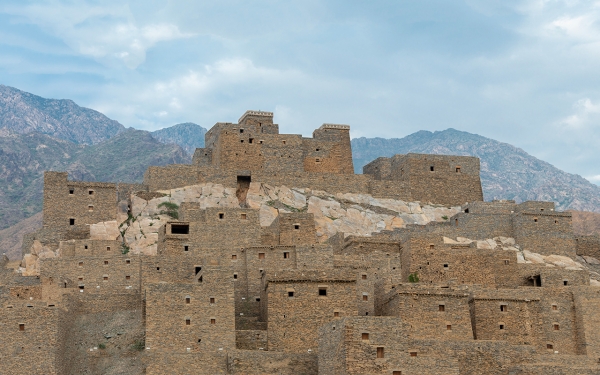
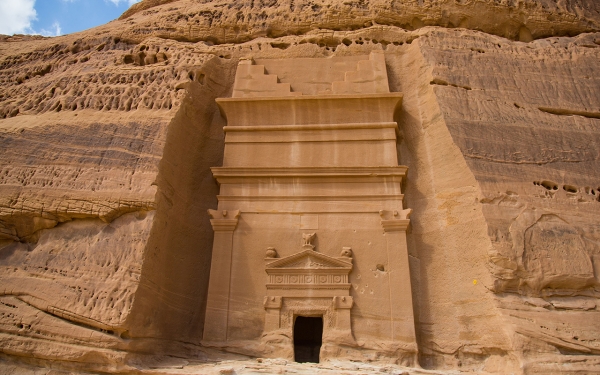
Tourism infrastructure in the Kingdom of Saudi Arabia refers to tangible sites that offer services to enhance the quality of domestic tourism, or facilities and laws that support the sustainability of tourism as one of the Kingdom's economic pillars. In general, infrastructure is defined as the physical components of interrelated systems providing commodities and services essential to enable, sustain, or enhance societal living conditions, and maintain the surrounding environment
With continuous efforts to develop tourism infrastructure, the Kingdom achieved a significant milestone in 2022 within the World Economic Forum (WEF) Travel and Tourism Development Index (TTDI.) This propelled the Kingdom to thirty-third place globally, advancing ten positions compared to 2019.
The main components of the tourism infrastructure are distinct across the Kingdom's thirteen administrative regions, including major cities. The tourism sector aims to become a major contributor to the diversified economy of the Kingdom, contributing over 10 percent to the Gross domestic product (GDP,) supported by substantial investments in entertainment and tourism infrastructure.
The Quality of Life Program also contributes to the growth of the tourism sector targeting both domestic and international tourists. This, in turn, enhances the Kingdom's standing as a worldwide tourist hotspot. Three entities lead this sector: the Ministry of Tourism, the Saudi Tourism Authority, and the Tourism Development Fund.
In 2022, the Ministry of Tourism launched the world's most extensive tourism training program, called "Tourism Pioneers." The program aims to develop the skills of one hundred thousand young men and women in hospitality, tourism, and travel to prepare them to work in the Kingdom's thriving tourism sector.
Tourism infrastructure in Riyadh
Riyadh is known as a modern city with a distinctive cultural heritage and contemporary architectural styles. However, it is also home to several historical and cultural heritage sites and villages, such as al-Masmak Palace, Ushaiqer Heritage Village, and al-Murabba Palace.
A key tourist attraction in Riyadh is the historic city of Diriyah and al-Turaif District, listed as a United Nations Educational, Scientific and Cultural Organization (UNESCO) World Heritage Site. Additionally, Riyadh is abundant with festivals and tourist events during the holiday seasons.
Tourism infrastructure in Makkah
Jeddah stands out as a city with diverse coastal sites and the largest seaport overlooking the Red Sea, which boasts rich coral reefs. It is also a major commercial hub in the region, serving as the gateway to Makkah. It is home to the historic Jeddah, a UNESCO-listed heritage site.
Among the main components of the tourism infrastructure in Makkah are six football stadiums, one of which is international. The region boasts a total of thirty-one museums, with thirteen being public and eighteen privately owned. Makkah is special for having three historic palaces: al-Saqaf Palace, King Faisal Palace, and al-Zaher Palace. Additionally, Jeddah is home to a race track for cars.
Tourism infrastructure in Madinah
Madinah is culturally characterized as a city with sacred religious landmarks. It houses the second holiest mosque, the Prophet's Mosque, and is home to some of the most prominent mosques in the country, such as Quba Mosque, Qiblatain Mosque, al-Ghamamah Mosque, and the Seven Mosques. It is also known for its historical battle sites, heritage tourist attractions, and remarkable terrain in the surrounding mountains.
Among the main components of the tourism infrastructure in Madinah is the Prince Mohammed bin Abdulaziz Sports City and eighteen museums, including seven public and eleven private museums. It also features the first heritage site listed on UNESCO's World Heritage List in 2008: Hegra Archaeological Site or Mada'in-Saleh.
Tourism infrastructure in Eastern Province
Dammam is known for its industry, beaches, expansive sea, and fishing spots, making it a vital hub for pearl trading and fishing. It is also a space for coastal sports cities, craft enthusiasts, and shipbuilding. Culturally, it thrives with various festivals and the production of oil and chemical industries.
Among the important components of tourism infrastructure in the Eastern Province are four sports stadiums: the Directorate of Education Stadium, Prince Mohammed bin Fahd Stadium in Dammam, Prince Saud bin Jalawi Sports City Stadium in Rakah, and Prince Nayef bin Abdulaziz Stadium. The region also has three significant archaeological sites: Ibrahim Palace, Tarout Castle, and the Old Town. The total number of museums is thirty-nine, comprising twelve public museums and twenty-seven private ones. Furthermore, the region is home to the "Mahara" karting skill circuit that simulates a sports racing track.
Tourism infrastructure in Tabuk
Similar to Jeddah and Dammam, Tabuk is known as the region of the sea and coral reefs. It stands out for its diverse beaches along the coastline and snow-draped mountains during winter. It is an important site for coral reefs, attracting diving enthusiasts and fishermen. Tabuk is also renowned for safeguarding its natural reserves and cultural heritage. It houses thirteen museums, including six public and seven private museums, constituting the main components of the tourism infrastructure in Tabuk. The Saudi Vision 2030 initiatives led by the Public Investment Fund, including NEOM, the Red Sea Project, and Amaala, are set to bring about a significant cultural transformation in the region.
Tourism infrastructure in Qassim
Qassim stands out in its history, varied agriculture, and welcoming expanse for sand dune off-road enthusiasts. It is the richest in agriculture and houses the world's largest market for dates. Buraidah Date Festival, organized by the Ministry of Environment, Water, and Agriculture, in partnership with the National Center for Palms and Dates, is one of the largest economic events worldwide. It is also home to the largest palm farm in the world and annually holds the Buraidah Festival for Klaija (a traditional pastry) and traditional products. The total number of museums in Qassim is twenty-five, including two public and twenty-three private museums.
Tourism infrastructure in Hail
Hail is known as a city of diverse nature and cold weather. It boasts organized spaces in the desert, valleys, mountains, and oases, along with its cold and moderate climate. Equestrian culture and Arabian horse competitions are popular in Hail. The city hosts the annual Desert and Summer Festival, as well as the Hail International Rally. It is also a hub for traditional arts, songs, and poetry, most notably, Samri Hail.
Among the main components of tourism infrastructure in the Hail region are three diverse historical sites, including a complete archaeological city. The region also has eleven museums, including one public and ten private museums. A particularly significant highlight is the presence of a UNESCO-listed World Heritage Site known as the Rock Art Site in Jubbah and Shuwaymis.
Tourism infrastructure in Najran
Najran is characterized by a number of natural elements, history, heritage, traditional industries, folklore, traditional dances, sports centers, natural gardens, wells, and underground water. The main components of the core infrastructure in Najran revolve around the flourishing of archaeological sites, such as the historic Emirate Palace, and three museums, including one public and two private museums. Additionally, Hima Cultural Area was registered on UNESCO's World Heritage List in 2021.
Tourism infrastructure in Aseer
Abha is distinguished as a city with unique weather and breathtaking mountains. It is one of the cities that combine natural and economic elements within its tourism program. It includes landmarks, palaces, old markets, as well as modern commercial centers. Due to its mountainous environment, it offers diverse activities, such as mountain climbing, mountain biking, and paragliding. It also hosts cultural and folk festivals.
In general, the main components of the core infrastructure in Aseer are highlighted by the Prince Sultan bin Abdulaziz Sports City Stadium and the wildlife reserves, such as the Aseer National Park. It also includes various amusement parks, such as al-Salam Park and Abha Palace Park, and fifty museums, including cultural and historical museums, with three public and forty-seven private museums.
Tourism infrastructure in Northern Borders Region
The Northern Borders Region is characterized by its breathtaking nature, making it a preferred tourist destination. It includes many valleys and plains, such as Arar Valley, al-Awaisi Valley, and Badanah Valley, as well as hills and mountains like Kutayfah Mountain. The region is also known for its abundant agriculture, where natural herbs flourish.
The region houses several heritage sites, including the historic King Abdulaziz Palace in Linah, Rafha Province, with an area of approximately 4,320 m².
It has three private and one public museum.
Tourism infrastructure in al-Jawf
Al-Jawf is considered an important tourist destination in the Kingdom because of its rich historical and cultural heritage. Its traces date back thousands of years and it celebrates seasonal festivals and harvest festivals. The region is home to a number of architectural treasures, including Omar bin al-Khattab Mosque, one of the oldest mosques in the Kingdom, and the Rajajil Standing Stones site, a repository of carved stones dating back over 6,000 years, as well as more than fifty tombs and ten graves. It also benefits from its convenient location near mega-projects, e.g., NEOM and AlUla.
Al-Jawf also has a rich nature with abundant resources and great potential in the field of eco-tourism, with King Salman Natural Reserve serving as an ideal base for eco-tourism. Dumat al-Jandal Lake is an exemplary site for water sports activities and recreational resorts, utilizing its sulfur abundance for medical tourism.
Moreover, the region boasts numerous tourist attractions, such as Zaabal Castle in Sakaka and the oldest human settlement in Shuweihtia Village. Al-Dar'a or al-Dhil neighborhood in al-Jawf, with its stone buildings and narrow alleys dating back about 200 years, is also noteworthy, along with some historical forts, such as Marid Castle in Dumat al-Jandal.
Tourism infrastructure in Jazan
Jazan offers diverse natural elements, including the seas, islands, mountains, and plains. It is renowned for its hot springs, mountains, seasonal fruit festivals, sports events, and adventure activities. Among the main components of the core infrastructure in Jazan are nine museums, including one public and eight private museums, as well as tourist attractions, such as the Heritage Village, the Southern Corniche, Marjan Island Park, Farasan Island, and Wadi Lajb.
Tourism infrastructure in al-Baha
Al-Baha enjoys an exemplary location that encompasses breathtaking natural landscapes and historical landmarks. These include its ancient caves in the Shada Mountains, Mount Dhi Ain al-Rakhami, and Wadi Jadar. Al-Baha witnesses a high demand in specific sectors such as hotel services, hospitality, restaurants, cafes, and recreational facilities, where outdoor activities, adventures, and excursions can be pursued in numerous distinguished areas. This includes Raghadan Forest Park and Khirah Forest, known for their dense forests, stunning mountain views, and moderate weather.
The core infrastructure in al-Baha encompasses a regional museum, six private museums, and several heritage sites. These include the Dhi Ain Village in Qilwah, situated atop a rugged white rocky mountain with commanding views of Wadi Rash to the west. Another prominent site is the Bin Raqoush Palace in the Bani Sar village, north of al-Baha. This palace is nestled on a hillside and showcases a compilation of heritage structures, contributing to the rich historical tapestry of the region. The palace is a tourist and historical landmark in the region.
Related quizzes
